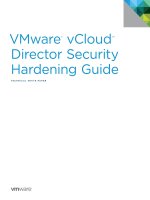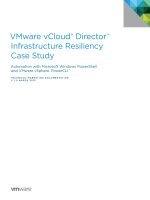Storage Considerations for VMware® vCloud™ Director pptx
Bạn đang xem bản rút gọn của tài liệu. Xem và tải ngay bản đầy đủ của tài liệu tại đây (2.4 MB, 11 trang )
Storage Considerations
for VMware
®
vCloud
™
Director
VMware vCloud Director Version 1.0
T E C H N I C A L W H I T E P A P E R
T E C H N I C A L W H I T E P A P E R / 2
Storage Considerations for
VMware vCloud Director
Introduction
VMware® vCloud™ Director is a new solution that addresses the challenge of rapidly provisioning resources in
VMware vSphere™ 4.1 (“vSphere”) to support multitenancy environments. It adds a layer of automation, security
and simplicity built for both internal private networks, for large enterprises, as well as large cloud deployments,
for service providers. With this release VMware has created a new administrator role within the virtualized
datacenter. The role of a vCloud Director administrator as well as a cloud consumer means that some new layers
of management will require understanding of new terminology and concepts. This paper has been written to
explain the relationships of both the storage-resource and storage-management functions introduced by vCloud
Director, as well as to provide an overview of the steps taken to provision storage in vCloud Director and to share
some best practices and consideration for deployment.
The intended audience for this paper is storage-focused technical personnel who have a strong understanding
of vSphere 4.1. This paper assumes the reader has a solid command of the VMware concepts and terminology.
VMware vCloud Director Overview
VMware vCloud Director is a software solution that enables enterprises to build secure, multitenant private
clouds by pooling infrastructure resources into virtual datacenters and exposing them to users through
Web-based portals and programmatic interfaces as fully automated, catalog-based services.
By building secure and cost-eective private clouds with VMware vSphere and VMware vCloud Director, internal
IT organizations can act as true service providers for the businesses they support, driving innovation and agility
while increasing IT eciency and enhancing security. This solution provides a pragmatic path to cloud
computing by giving customers the power to leverage existing investments and the flexibility to extend capacity
between clouds.
The intent of vCloud Director is to help move the datacenters of the virtualized world closer to the true value of
cloud computing. vCloud Director provides automation and reduced management intradependencies of
compute, network and storage. The specific focus of this paper is on storage. Virtualized compute, network and
storage resources created in a vSphere environment can now be grouped into logical virtual data centers (VDC)
that can be safely shared by many consumers.
VMware vCloud Director Environment
vCenter vCloud
Management cluster
3 x Dell PE 2950
(2 cpu, 32 GB RAM per server)
4 x HP DL 380 G6
(2 cpu, 24 GB RAM per server)
RP 01
VMware
vCloud
Director
Chargeback
vCenter
Server
vShield
Manager
Directory
services,
DNS, DHCP
Primary
Directory
services,
DNS, DHCP
Secondary
Oracle
database
SQL
Server
database
FC Storage iSCSI Storage NFS Storage
RP 02 RP 03
Private cloud cluster
Figure 1. VMware vCloud Architecture Overview.
T E C H N I C A L W H I T E P A P E R / 3
Storage Considerations for
VMware vCloud Director
VMware vCloud Director Storage Overview
In the vCloud Director environment, the provider exposes a set of virtualized compute, storage and networking
resources to be consumed by users in the cloud. The pooling of pure virtual resources will be defined and
managed through vCloud Director by the administrator in a way that oers both elasticity and scalability. From
the user (consumer) perspective the storage resources appear as a limitless pool of storage that has a uniform
performance characteristic and cost. The goal of vCloud Director is to provide consumers with limitless storage
capacity so that they can consume as much as possible if they are willing to pay for it.
VMware vCloud Director Terminology
A Provider VDC is a combination of compute and storage resources. One can take compute and storage
resources with specific characteristics, such as cost and performance, and combine them and create a Provider
VDC. When this is done, one can logically tier pools of compute and storage resources into multiple-service
oerings, each implemented by one or more Provider VDCs. Each Provider VDC will have an SLA and cost
associated with it and is intended to be a shared resource.
VMware vCloud Director allows you to create Organizations to separate groups of users from each other and
apply dierent policy controls. Each Organization can contain dierent groups of users that has its own set of
resources and policies.
VMware vCloud Director creates a separate Web-based access point (URL) for each Organization where users of
that Organization log in. Inside Organizations, one can create users and groups. Users can be authenticated in
three dierent ways:
LocallyagainsttheVMwarevCloudDirectordatabase
SystemwideVMwarevCloudDirectoractivedirectoryorLDAPserver
Organization-specificactivedirectoryorLDAPserver
An Organization VDC is a resource container that contains compute and storage resources and has a specific
SLA and cost associated depending on which Provider VDC it is created from.
Organization VDCs are created so that Organizations can use resources from Provider VDCs.
An Organization VDC can grow to be as large as the size of a Provider VDC. An Organization can use resources
through multiple Organization VDCs created from multiple Provider VDCs.
There are three ways of consuming resources from a provider VDC.
PayPerVirtualMachine(VM)
a Thereisnoupfrontresourceallocation
b OrganizationVDCresourcesareallocatedonlyasuserscreatevApps
c Onecansetlimitstocapusage
d Onecanguaranteeapercentageoftheresourcesbeingusedtoprovideovercommitmentof
computeandmemoryacrossyourcloud
ReservationPool
a AnOrganizationVDCisallocateda“container”setofresources
b OrganizationscanuseadvancedvSphereresource-managementcontrolssuchasSharesand
ReservationstomanageovercommitmentoftheirresourcesbetweentheirworkloadsSome
moresophisticatedaspectsofresourcemanagementareownedbythecloudtenantandnot
thecloudoperator
T E C H N I C A L W H I T E P A P E R / 4
Storage Considerations for
VMware vCloud Director
AllocationPool
a AnOrganizationVDCisallocateda“container”setofresources
b Organizationshaveverysimplemodelsofresourcesandadvancedresource-managementcontrols
suchasSharesandReservationsaremanagedbythecloudoperatorthusenablingmorecoherent
resourcemanagementacrossOrganizations
Pooling of Storage Resources
A Provider VDC is a resource pool of a cluster of VMware ESX® servers that access a shared storage resource.
The Provider VDC can contain: 1) part of a datastore (shared by other Provider VDCs); 2) all of a datastore; or 3)
multiple datastores. As storage is provisioned to Organization VDCs, the shared storage pool for the Provider
VDC is seen as one pool of storage with no distinction of storage characteristics, protocol or other
characteristics that dierentiate it from being more than just one large address space.
In the case of a Provider VDC that is comprised of more than one datastore, it is considered best practice that
those datastores have equal performance capability, protocol and quality of service. If this is not the case, the
performance of that Provider VDC storage pool will be impacted by the slower storage in the collective pool.
Some VDCs might end up with faster storage than others.
In order to gain the benefits of dierent storage tiers or protocols, one will need to define separate Provider
VDCs where each Provider VDC would have storage of dierent protocols or diering quality-of-service storage.
For example, one might provision a Provider VDC that is built on a datastore backed by 15K RPM FC disks with
loads of cache in the disk for the highest disk performance tier, and a second Provider VDC that is built on a
datastore backed by SATA drives and not a lot of cache in the array for a lower tier.
It should be noted that when a Provider VDC has a datastore that is shared with another Provider VDC one may
find the performance of one Provider VDC is causing performance impact on another Provider VDC. So, it is
considered best practice to have a Provider VDC that has a dedicated datastore such that isolation of the
storage reduces chances of introducing the existence of dierent quality-of-service storage resources in one
Provider VDC.
Org VDCs in FC PVDC
vCloud DirectorvSphere ESXi/ESX
Server
Storage Array
Org VDCs in iSCl PVDC Org VDCs in NFS PVDC
FC Datastore
FC LUN
iSCSl Datastore
iSCSl LUN
NFS Datastore
NFS Device
FC PVDC iSCSl PVDC NFS PVDC
Figure 2. Logical Boundaries Separating Storage Types.
T E C H N I C A L W H I T E P A P E R / 5
Storage Considerations for
VMware vCloud Director
vCloud Director Storage Requirements
Deployment of VMware vCloud Director requires storage for several elements of the overall architecture. The
first use of storage is the storage needed to house the management cluster of vCloud Director. This will include
the repository for information about the configuration, Organizations and allocations that are stored in an Oracle
database. That storage requirement is called out in the configuration guide and evaluation guide.
The second storage requirement is the vSphere storage objects that are presented to vCloud Director as
datastores accessed by ESX servers in the vCloud Director configuration. This storage is managed by the
vSphere administrator and is consumed by vCloud Director users pursuant to how the vCloud Director
configuration is used at that higher level of abstraction.
It is this third element of storage management on which the remainder of this paper will focus. It will explain how
one configures, manages and monitors the storage made available through vSphere for consumption by users
within the scope of the vCloud Director. As a basic installation, it is required that there be at least two vSphere
datastores presented to vCloud Director of about 300GB or larger in size, preferably, datastores with dierent
storage performance capabilities. An additional storage requirement for deployment of vCloud Director is the
existence of a single NFS datastore to serve as a staging area for vApps to be uploaded to a Catalog.
Assuming the management cluster of vCloud Director is installed as outlined in the installation guide and
vSphere has been set up such that datastores are available to the vCloud Director configuration, we will now run
through the steps making storage available to consumers of the vCloud Director environment.
Steps for Configuring Storage in VMware vCloud Director
The basic steps for provisioning storage for vCloud Director are as follows:
• Create datastores within vSphere for use by vCloud Director.
• Confirm that the datastores are visible in the vCloud Director console.
• Create Provider VDCs by associating compute resource pool with shared storage.
• Create Organizations.
• Create Organization VDCs.
• Deploy vApps and consume storage resources in Organization VDC.
Typically the first step above is done by the vSphere administrator. Steps 2 through 5 are done by the vCloud
Director administrator. And the last step is done by the cloud end-user community.
Viewing the Datastores Within vCloud Director
From within the vCloud Director console one can view the vSphere storage resources available for building
Provider VDCs by selecting the “Datastore” icon from the Manage and Monitor tab. In the case of the example
shown in Figure 3, there are three datastores available. The attributes of these datastores are reflected in the
columns shown in Figure 3.
T E C H N I C A L W H I T E P A P E R / 6
Storage Considerations for
VMware vCloud Director
Figure 3. Listing of Available Datastores for vCloud Director Configuration.
Additional information about the properties of each of these datastores may be viewed by clicking on a specific
datastore and selecting properties via a right-click on the line for that datastore. As shown in Figure 4, the
specific path or unique identifier is reflected as the second line in this screen. This is a very important attribute
for mapping the vCloud Director shared-storage resources back to the vSphere infrastructure. It can be very
helpful information that needs to be shared with the vSphere administrator if confusion exists between the
vCloud Director administrator and vSphere administrator as to which datastore has been mapped to which
Provider VDC.
Figure 4. Properties of a Datastore Exposed to vCloud Director.
T E C H N I C A L W H I T E P A P E R / 7
Storage Considerations for
VMware vCloud Director
Viewing the Storage Attributes of a Provider VDC
Once a Provider VDC has been created, the attributes of the storage allocation, usage and properties can also be
viewed through the Manage and Monitor screen by selecting a given Provider VDC as listed under the Provider
VDCs, as shown in Figure 5.
Figure 5. Details About Resources Available in a Specific Provider VDC.
One can also view attributes about this allocation by selecting the Provider VDCs screen and getting detailed
information about each of the Provider VDCs by doing a right-click on the line in the listing and selecting
properties. One can also add information about this Provider VDC in the description field.
Viewing Attributes About Storage in an Organization VDC
The next step in allocating storage is to create Organization VDCs and in doing so creating a grouping of
resources for use by a specific group of users. As a Provider VDC is a grouping of ESX servers, storage and
network resources, the Organization VDCs is a further division, or allocation from within a given Provider VDC,
of compute resources to specific consumers of these resources. This is one means by which multitenancy is
accomplished and enforced. The Organization can either be a department in a company, for enterprise
deployments, or a company with service-provider deployments.
The creation of the Organization and the Organization VDCs is clearly explained in the Administrative Guide for
vCloud Director. It is important to call out the fact that, from a storage perspective, an Organization VDC is
contained within a single Provider VDC. So the size of a single Organization VDC cannot be larger than the size
of the Provider VDC in which it resides. And there is no way for an Organization VDC to have access to multiple
tiers of storage through vCloud Director. Although NFS storage could be connected directly from the VM via a
remote mount, the idea that an Organization VDC could have tiered storage is not an option oered with
vCloud Director.
Once an Organization VDC has been created, the allocation of CPU, memory and storage can be viewed, as
shown in Figure 6.
T E C H N I C A L W H I T E P A P E R / 8
Storage Considerations for
VMware vCloud Director
Figure 6. Details of a Specific Organization VDC.
The storage tab shows the amount of storage assigned to the Organizaion VDC as well as the consumption limit
for this Organization VDC. This limit is defined when the Organization VDC was created and can be increased or
decreased through this screen within the limits of what storage remains available in the Provider VDC. As shown
in Figure 7, this Organization VDC has thin provisioning enabled such that each virtual disk will be a thin-
provisioned VMDK upon creation of the VMs.
Figure 7. Storage Properties and Limit Settings for a Given Organization VDC.
T E C H N I C A L W H I T E P A P E R / 9
Storage Considerations for
VMware vCloud Director
Considerations for Use of vSphere Storage and Arrays Features
In vSphere, there are several storage-management features and one needs to consider their impact when used
with a given deployment of vCloud Director. There are some features that are transparent to vCloud Director and
are complementary, while others that are transparent can be disruptive.
Enabling Storage I/O Control (SIOC) in vSphere for a datastore that is used by vCloud Director would alleviate
congestion that might lead to latency if SIOC were not enabled.
The use of device multipath and even Multi-Path Plug-ins (MPP) is complementary. And so is the use of NIC
teaming with iSCSI and NFS datastores.
The use of VMware Storage vMotion™ can be used with good results if the Provider VDC consists of several
datastores and Storage vMotion is used to balance the load of VMs on those datastores. However, it could also
be very disruptive if the vSphere administrator happens to move a VM from one Provider VDC to another
Provider VDC, not realizing that this would stop the vCloud Director from managing the VM. Therefore, the
vSphere administrator managing a combined infrastructure of VDC and non-VDC resources in the same vCenter
might issue a storage vMotion out of habit that could break the VDC environment by mistake.
Use of VMFS Volume Grow is a good way to increase the size of a datastore upon which the Provider VDC could
then also be expanded.
Linked clones are not supported with vCloud Director in this release.
Site Replication Manager (SRM) is also not supported with vCloud Director at this time.
Features within the underlying storage array, such as thin provisioning or deduplication, would be fine, whereas
storage array snapshot or replication may have larger implications for vCloud Director deployment than they
might with vSphere due to the additional layers of abstraction.
Mapping Storage Usage from vCloud Director to vSphere vCenter
As vCloud Director adds an additional layer of abstraction of virtualization on top of vSphere virtualization, this
brings up a question: How does one map objects used by Organizational VDCs and Provider VDCs to specific
objects as seen by vCenter Management Server? The best way to map logical resources used by vCloud Director
back to vSphere resources is to open two management consoles: 1) vCloud Director management interface; and
2) vCenter Management Server interface for the underlying infrastructure, and compare the two as you build out
the deployment.
As shown in Figure 8, there will be a resource pool for each Provider VDC created. Organization VDC folders are
created under the Provider VDC folders. And each Organization VDC folder will have its name prefixed with a
number to ensure uniqueness across vCenter server instances. Within each Organization VDC folder there will
be a virtual machine directory and icon for each vApp deployed. However, the vApps will not have the vApp icon
as one might expect.
T E C H N I C A L W H I T E P A P E R / 1 0
Storage Considerations for
VMware vCloud Director
Figure 8. vCenter View of the vCloud Director Allocations.
Summary of Best Practices
In summary, it is best practice to:
• Build Provider VDC with large dedicated datastores (generally 1TB)
• Define storage tiers by creating separate Provider VDCs
• Use naming convention for Provider VDCs and Organization VDCs that will help the vSphere administrator
recognized that the objects are vCloud Director objects and to minimize confusion
• Work closely with vSphere administrator to ensure that infrastructure is provisioned and monitored for
best performance and availability, ensuring that multipath and redundant components are configured for
maximum high availability
• Zone storage only for the hosts in the cloud cluster; this will help prevent storage vMotion of virtual
machines to other clusters in vCenter server that are not used by vCloud Director
Storage Considerations for
VMware vCloud Director
Conclusion
The introduction of vCloud Director enables both enterprise datacenter managers and service providers with
many new ways to reduce the cost of provisioning virtualization environments for consumption with a reduction
of management overhead. It layers on top of vSphere infrastructure in a way that oers greater speed in
provisioning, isolation for multitenancy consumption and provision of workspace for consumption based on
several new means of chargeback. However, as this is a powerful new capability, it does also require one to
understand some new concepts and terminology to make full use of this new technology. As it pertains to
storage, vCloud Director introduces two new layers of abstraction that both simplifies the allocation of storage
and also introduces new concepts for resource administration. The benefits gained in automation, multitenancy
and chargeback capability provide significant reduction of management overhead and increase the agility and
scalability needed to build and manage virtualized computing assets, making it easier to achieve the benefits of
cloud computing.
About the Author
Paul Manning is a Storage Architect in the Technical Marketing group at VMware and is focused on virtual
storage management. Previously, he worked at EMC and Oracle, where he had more than ten years’ experience
designing and developing storage infrastructure and deployment best practices. He has also developed and
delivered training courses on best practices for highly available storage infrastructure to a variety of customers
and partners in the United States and abroad. He has authored numerous publications and presented many talks
on the topic of best practices for storage deployments and performance optimization.
VMware, Inc. 3401 Hillview Avenue Palo Alto CA 94304 USA Tel 877-486-9273 Fax 650-427-5001 www.vmware.com
Copyright © 2010 VMware, Inc. All rights reserved. This product is protected by U.S. and international copyright and intellectual property laws. VMware products are covered by one or more patents listed
at VMware is a registered trademark or trademark of VMware, Inc. in the United States and/or other jurisdictions. All other marks and names mentioned herein may be
trademarks of their respective companies. Item No: VMW_10Q3_WP_Storage_p11_A_R2









